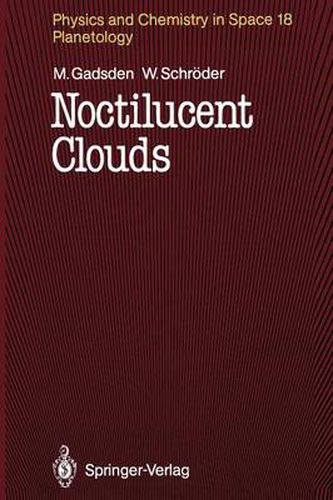Readings Newsletter
Become a Readings Member to make your shopping experience even easier.
Sign in or sign up for free!
You’re not far away from qualifying for FREE standard shipping within Australia
You’ve qualified for FREE standard shipping within Australia
The cart is loading…






This title is printed to order. This book may have been self-published. If so, we cannot guarantee the quality of the content. In the main most books will have gone through the editing process however some may not. We therefore suggest that you be aware of this before ordering this book. If in doubt check either the author or publisher’s details as we are unable to accept any returns unless they are faulty. Please contact us if you have any questions.
An atmospheric phenomenon is considered as ‘explained’ when we have succeeded in deducing it on the basis of accepted principles of physics. (H. Ertel, Methods and problems of dynamical meteorolo gy,p. l) Until recently, noctilucent clouds were regarded merely as a curious atmos pheric phenomenon, the occurrence of which aroused only limited scientific attention. However, in the last two decades the interest they have been given has markedly increased. The clouds, usually pale blue in colour, may be seen on a clear night at high latitudes. Typical examples are illustrated in the book. Clouds looking like these in daytime would be classified as cirrostratus. What sets noctilucent clouds apart is their occurrence in the middle of the night, their very obvious pale blue colour, and their disappearance into the dawn close to the onset of civil twilight when the Sun is 6 Degrees below the horizon. as being set apart from ordinary Noctilucent clouds were first recognized clouds in 1884/1885 and in a series of sightings that followed their return in the summer of 1885. That year marked the beginning of observations and the interpretation of twilight phenomena. The impetus came from the extraordi nary Krakatoa eruption, which was not only one of the most spectacular volcanic eruptions in recorded history, but which also turned out to be a startling event in atmospheric science with repercussions even in our time.
$9.00 standard shipping within Australia
FREE standard shipping within Australia for orders over $100.00
Express & International shipping calculated at checkout
This title is printed to order. This book may have been self-published. If so, we cannot guarantee the quality of the content. In the main most books will have gone through the editing process however some may not. We therefore suggest that you be aware of this before ordering this book. If in doubt check either the author or publisher’s details as we are unable to accept any returns unless they are faulty. Please contact us if you have any questions.
An atmospheric phenomenon is considered as ‘explained’ when we have succeeded in deducing it on the basis of accepted principles of physics. (H. Ertel, Methods and problems of dynamical meteorolo gy,p. l) Until recently, noctilucent clouds were regarded merely as a curious atmos pheric phenomenon, the occurrence of which aroused only limited scientific attention. However, in the last two decades the interest they have been given has markedly increased. The clouds, usually pale blue in colour, may be seen on a clear night at high latitudes. Typical examples are illustrated in the book. Clouds looking like these in daytime would be classified as cirrostratus. What sets noctilucent clouds apart is their occurrence in the middle of the night, their very obvious pale blue colour, and their disappearance into the dawn close to the onset of civil twilight when the Sun is 6 Degrees below the horizon. as being set apart from ordinary Noctilucent clouds were first recognized clouds in 1884/1885 and in a series of sightings that followed their return in the summer of 1885. That year marked the beginning of observations and the interpretation of twilight phenomena. The impetus came from the extraordi nary Krakatoa eruption, which was not only one of the most spectacular volcanic eruptions in recorded history, but which also turned out to be a startling event in atmospheric science with repercussions even in our time.